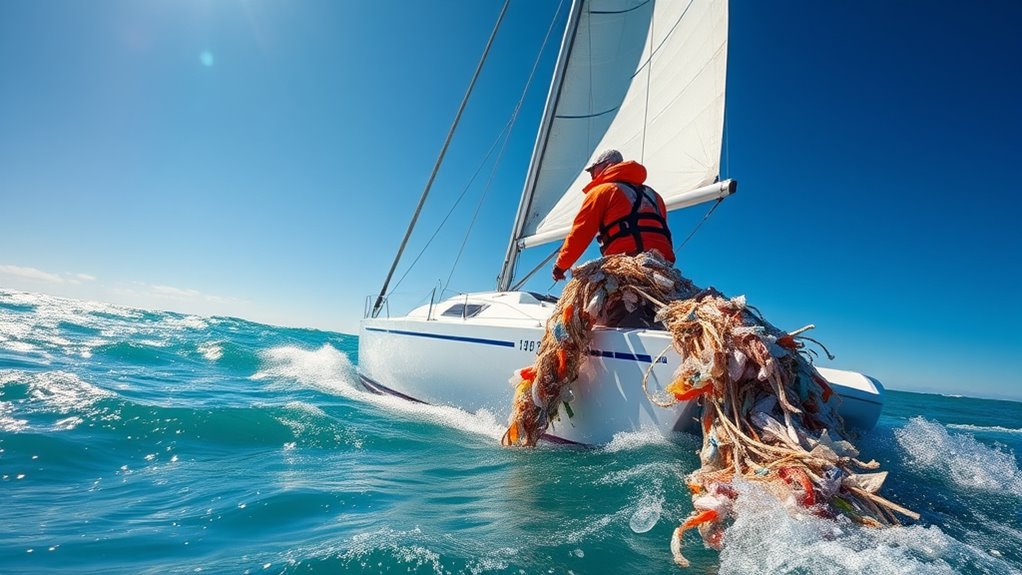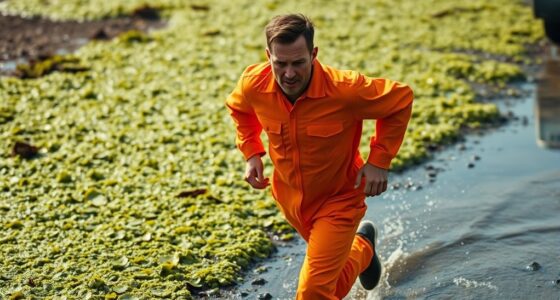Ocean Avenger is a dedicated solo sailor who has removed over 10,000 pounds of plastic from the ocean by using innovative techniques and equipment like manual nets, sieves, and automated collection systems. Driven by a passion to protect marine life and ecosystems, they face weather challenges and logistical hurdles but remain committed to raising awareness and inspiring others. If you keep exploring, you’ll discover how their efforts create a meaningful impact on ocean health.
Key Takeaways
- Ocean Avenger is a dedicated solo sailor committed to cleaning plastic waste from remote ocean areas.
- He has successfully removed over 10,000 pounds of plastic debris using manual and innovative collection methods.
- Equipped with specialized tools and IoT technology, he monitors and enhances his cleanup efforts effectively.
- His mission focuses on protecting marine ecosystems, reducing microplastics, and raising public awareness.
- He actively engages communities and collaborates with organizations to expand his impact beyond individual efforts.
The Inspiration Behind Ocean Avenger’s Mission

The inspiration behind Ocean Avenger’s mission stems from a growing awareness of the devastating impact plastic pollution has on oceans and marine life. You realize that every piece of plastic floating in the water threatens countless species, from tiny microplastics to large debris. Witnessing the harm firsthand, you feel compelled to take action. You see pristine beaches marred by trash and marine animals ensnared or ingesting debris. This fuels your drive to make a difference, even alone. Your goal is to combat this crisis by actively removing plastic waste from remote ocean areas others can’t reach. The mission is personal—an urgent response to protect the ecosystems you cherish and ensure cleaner, healthier oceans for future generations. Leveraging predictive analytics can help identify hotspots of plastic accumulation for more targeted cleanup efforts. Data-driven approaches can enhance the precision and effectiveness of cleanup operations. Incorporating advanced sensing technologies enables real-time detection of debris, maximizing cleanup efficiency. Additionally, embracing innovative solutions like autonomous cleanup vessels can further amplify your impact, demonstrating how technology can be harnessed for environmental preservation.
Techniques and Equipment Used for Plastic Collection

Using a small sailboat equipped with specialized tools, Ocean Avenger employs manual and mechanical techniques to collect plastic waste from the ocean. You use hand nets and grabbers for larger debris, while mechanical devices like sieves and nets tackle microplastics. To optimize efficiency, you regularly upgrade your equipment and maintain tools to guarantee durability. The following table summarizes your main techniques and gear:
| Technique | Equipment | Purpose |
|---|---|---|
| Manual retrieval | Hand nets, grabbers | Large debris collection |
| Microplastic filtering | Fine mesh nets, sieves | Small particles and microplastics |
| Mechanical collection | Automated nets | Bulk waste gathering |
| Storage and disposal | Waterproof containers | Onboard waste storage |
| Equipment maintenance | Tools, spare parts | Keep gear functional |
These methods allow you to efficiently remove plastic waste, even in challenging conditions. Utilizing innovative tools enhances your capacity to address diverse types of ocean plastic pollution effectively. Additionally, adopting advanced filtration systems can further improve microplastic collection efficiency. Implementing sustainable disposal practices ensures that collected waste is handled responsibly to minimize environmental impact.
Impact of the Cleanup on Marine Ecosystems

Removing plastic waste from the ocean directly benefits marine ecosystems by reducing threats to marine life and improving habitat health. When you eliminate debris, you prevent animals from ingesting or becoming entangled, which dramatically lowers mortality rates. This cleanup also helps restore natural habitats, allowing coral reefs, seagrass beds, and coastal environments to recover and flourish. Microplastics, which can bioaccumulate in the food chain, are minimized, safeguarding the health of fish, seabirds, and other marine species. Your efforts contribute to cleaner water, boosting biodiversity and ecosystem resilience. Additionally, promoting skincare innovation with ingredients that are environmentally friendly can further support ocean conservation efforts. By removing plastics, you help create an environment where marine life can thrive without constant threats from pollution, ultimately supporting healthier oceans that sustain both wildlife and human communities. Supporting ocean preservation initiatives amplifies these positive impacts and encourages sustainable practices worldwide. Engaging in public awareness campaigns can also educate communities about reducing plastic use and protecting marine environments.
Challenges Encountered on the Voyage

Beginning on ocean cleanup missions presents a range of formidable challenges that test even the most dedicated sailors. You face unpredictable weather, from fierce storms to calm but foggy days, making navigation and collection difficult. Limited storage on your small sailboat constrains how much waste you can carry, forcing you to plan trips carefully. The physical effort required to manually retrieve large debris and microplastics is exhausting, especially over long hours at sea. Disposal logistics become complex when you reach port, needing proper recycling channels. Funding shortages mean you often work with limited resources, impacting equipment maintenance and upgrades. Constant vigilance is essential to avoid hazards like drifting debris or equipment failure. Recognizing patterns of emotional coldness and other relationship challenges can be crucial for maintaining personal resilience during long, isolating missions. Implementing sustainable practices can also help mitigate some environmental and logistical issues faced during the voyage. Developing mental resilience strategies can further support mental health amidst these stresses. Additionally, adopting cybersecurity measures can safeguard your navigation and communication systems against potential threats, ensuring operational continuity during critical moments. Staying updated on the support hours of relevant organizations and services can also be vital for timely assistance when needed.
Engaging the Public and Raising Awareness

You can help raise awareness by sharing stories of Ocean Avenger’s cleanup efforts and successes. Collaborating with local communities and schools amplifies the message and encourages action. By promoting environmental education, you empower others to join the fight against ocean plastic pollution. Raising awareness also includes decoding modern slang, which helps connect with youth audiences and spread the message more effectively. Incorporating mindful decluttering strategies into community initiatives can further emphasize responsible consumption and waste reduction. Implementing affordable home security systems can also help protect community spaces and promote safety in environmental projects. Additionally, showcasing a variety of tea accessories and merchandise linked to environmental causes can inspire sustainable choices among supporters. Embracing smart IoT technologies in community efforts can enhance monitoring and maintenance of cleanup activities, ensuring long-term impact.
Sharing Ocean Cleanup Stories
Have you ever wondered how individual efforts can inspire global change? Sharing your ocean cleanup stories makes a powerful impact. When you post about your voyages, challenges, and successes, you motivate others to take action. Your firsthand experiences show that even one person can make a difference, turning abstract pollution facts into tangible stories. Photos and videos of your efforts highlight the real-world effects of plastic pollution and how cleanup makes a difference. Sharing also builds a community of like-minded individuals who want to protect the ocean. By communicating your journey, you raise awareness and encourage more people to get involved, creating a ripple effect that extends far beyond your own efforts. Your story can inspire others to join the fight against ocean plastic pollution.
Collaborating With Communities
Collaborating with communities is essential for amplifying ocean cleanup efforts and raising awareness about plastic pollution. When you engage local residents, schools, and organizations, you help foster a collective sense of responsibility. You can organize beach cleanups, workshops, and educational events that inspire action and highlight the importance of protecting marine environments. Sharing your journey and findings encourages others to get involved and understand the impact of plastic waste. By building partnerships, you create a network of motivated advocates who can sustain cleanup efforts long-term. Community collaboration also provides valuable insights and local knowledge, making your initiatives more effective. Incorporating smart home security systems can help safeguard community events and resources, ensuring safety during cleanup activities. Additionally, leveraging emotional intelligence can enhance communication and collaboration within the community, fostering stronger relationships and commitment. Fostering community engagement is crucial for maintaining momentum and ensuring that the efforts are inclusive and impactful. Together, you can drive meaningful change, reduce pollution, and motivate broader societal shifts toward more sustainable waste practices.
Promoting Environmental Education
How can raising public awareness transform efforts to combat ocean plastic pollution? When you actively share the realities of plastic pollution, you empower others to take action. By using social media, public talks, and educational collaborations, you make the issue visible and urgent. This engagement motivates individuals to reduce plastic use, participate in local cleanups, and support policy changes. When more people understand how microplastics threaten marine life and human health, they’re more likely to change habits. Your efforts in promoting environmental education create a ripple effect, inspiring communities, schools, and policymakers to prioritize ocean health. The more awareness you raise, the stronger the collective push toward sustainable practices and meaningful change. Your voice truly helps turn awareness into tangible action.
Future Goals and Ongoing Efforts

You can help expand collection areas to reach more remote parts of the ocean, increasing the impact of cleanup efforts. Developing new technologies will make waste retrieval more efficient and effective. Building stronger community partnerships will mobilize local support and amplify the fight against ocean plastic pollution.
Expanding Collection Areas
To effectively combat ocean plastic pollution, Ocean Avenger is actively working to expand its collection areas beyond its current focus. You’re aiming to reach more remote and less-explored regions where plastic accumulates but is often overlooked. By planning new voyages to distant island chains and under-sampled zones, you hope to increase the scale of waste removal. You’re also collaborating with other sailors and local communities to establish temporary collection points and share data on pollution hotspots. This expansion will help target microplastics and debris that typically evade current efforts. Your goal is to create a broader impact, ensuring that no part of the ocean remains untouched. With each new area, you bring hope for healthier, cleaner waters and a more exhaustive approach to ocean cleanup.
Developing New Technologies
Building on the efforts to expand collection areas, Ocean Avenger is also focusing on developing innovative technologies to enhance waste retrieval and processing. You’re working on new tools that make microplastic collection more efficient, like advanced sieves and automated nets. These innovations aim to increase the amount of debris captured per voyage while reducing manual effort. You’re also exploring portable recycling units on your boat to process plastics on-site, minimizing waste transport challenges. Here’s a quick look at your tech goals:
| Technology | Purpose | Status |
|---|---|---|
| Automated Nets | Improve debris capture | In development |
| Microplastic Sieves | Increase microplastic collection | Testing |
| Onboard Recycling | Reduce waste transport | Prototype |
Your ongoing efforts aim to revolutionize ocean cleanup, making it more effective and sustainable.
Building Community Partnerships
Establishing strong community partnerships is essential for expanding the impact of ocean cleanup efforts. By collaborating with local organizations, schools, and volunteers, you can amplify awareness and increase cleanup efficiency. Engage community members through educational programs, beach cleanups, and workshops that highlight the importance of reducing plastic waste. Partnering with businesses can also provide resources, funding, and innovative solutions to tackle pollution. Sharing your progress and data encourages collective action and builds trust. These partnerships create a network of committed advocates who extend your reach beyond individual voyages. Together, you can develop long-term strategies, advocate for policy changes, and inspire a broader movement to protect our oceans. Building community ties transforms isolated efforts into a powerful collective force for change.
Frequently Asked Questions
How Does Ocean Avenger Fund Its Ongoing Missions?
You can support Ocean Avenger’s missions through donations, crowdfunding campaigns, and sponsorships. He often raises funds via social media, public talks, and partnerships with environmental groups. Additionally, some funding comes from grants or educational programs that promote marine conservation. By contributing financially or spreading awareness, you help sustain his efforts to remove plastic from the ocean and inspire others to join the fight against pollution.
What Safety Measures Are in Place During Dangerous Sea Conditions?
You stay safe during dangerous sea conditions by monitoring weather forecasts closely and adjusting your plans accordingly. You wear appropriate safety gear, such as life jackets and harnesses, to prevent accidents. You communicate regularly with coast guards or emergency services, and keep emergency equipment onboard, like flares and radios. You also stay vigilant, avoiding risky areas, and know your limits, ensuring you’re prepared for any unexpected storms or rough seas.
How Is the Collected Plastic Properly Disposed of or Recycled?
You store the collected plastic on your boat until you reach port. There, you sort the debris by type and size, then deliver it to local recycling centers or waste management facilities. When recycling isn’t possible, you dispose of the waste responsibly, following environmental guidelines. This process guarantees that the plastic is either repurposed or safely removed from the environment, helping reduce ocean pollution effectively.
Does Ocean Avenger Collaborate With Other Ocean Cleanup Initiatives?
You might be surprised to learn that Ocean Avenger does collaborate with other cleanup initiatives. While primarily independent, you’ll find that sharing data, resources, and strategies with like-minded groups helps amplify impact. This cooperation allows for more efficient cleanups, broader awareness, and stronger advocacy efforts. By working together, you can maximize the reach of ocean conservation, making a bigger difference than operating alone.
What Criteria Determine the Most Polluted Areas for Targeted Cleanup?
You determine the most polluted areas by analyzing data on plastic accumulation, especially near island chains and gyres. You look for regions with high microplastic concentrations and large debris buildup. Weather patterns, ocean currents, and accessibility also guide your choices. By focusing on these hotspots, you maximize your cleanup impact and help protect marine life from the worst pollution zones.
Conclusion
As you follow Ocean Avenger’s journey, you can imagine the gentle whisper of waves carrying away the remnants of discarded plastic, leaving behind a cleaner, brighter sea. Every effort you support helps clear the ocean’s hidden treasures and fosters a healthier marine world. Together, you’re helping to nurture a vibrant underwater garden where life blooms freely. With each step forward, the ocean’s quiet resilience shines brighter, inviting you to be part of this inspiring renewal.







